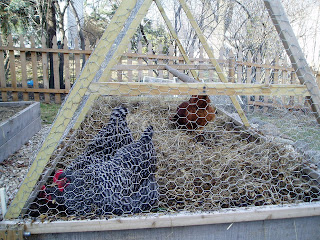

The snow has finally receded here on the frozen tundra of Wisconsin. (Southern Wisconsin, that is. I imagine they still have plenty of snow up north.) It’s amazing how fast big piles of snow can shrink once the weather warms.
So I put the girls to work turning the soil and fertilizing my raised beds. (I got the idea to make their tractor the same size as the raised beds for this purpose from Garden Girl.) They energetically dug deep into the soil, clucking contentedly the whole time. I always get a kick out of watching them. It’s like they’re thinking, “I’m SURE there’s something good to eat in here, somewhere. I just have to keep digging, and do it fast, before those other broads beat me to it!”
It’s such a relief to quit worrying about them out in the cold – and great satisfaction to see how well they came through the winter. Aren’t they gorgeous? I know, it’s hard to tell from the pictures above. But they wouldn’t hold still for a photo. Trust me when I say their coats are glossy, their combs have changed from pink with whitish dry patches back to bright red, and they have no sign of frostbite!
Many people told me they would get frostbitten and lose part of their combs, but not to worry! It won’t hurt them; you just won’t be able to show them. I never even thought of showing them – nor thought a little frostbite was acceptable. We worked hard to prevent that, although luck probably played a part.
Following the advice of our poultry extension specialist, we tried to ensure the coop stayed well-ventilated. The reason is that they are more susceptible to frostbite in cold humid air than in cold dry air. He recommended leaving the pop door open in winter for this reason. We could only bring ourselves to leave it half open at most. On very cold nights, we left it open only an inch or two. On a few extremely cold nights, we closed it completely.
I think we got away with it partly because I removed their droppings (collected in a tray under their perch) every morning. Droppings are a big source of humidity in the coop. We also put bag balm on their combs on the coldest nights – when they let us!
Sometimes Batgirl really fought this, and even held a grudge against Rick for about a week after he caught her and applied it. Since she had the smallest comb, and we didn’t want to upset her too much, we let it go when she resisted. Her comb is beautiful now, and even has grown enough that it’s hard to tell her apart from the other Barred Rock.
Although we didn’t heat the coop, Rick did put two 2+ gallon plastic gas cans (which had never held gas) filled with very hot water in the coop at night. This raised the temperature inside the tiny coop 10-15 degrees!
I also believe that giving them greens all winter helped keep them healthy. I have no extension research or other “authoritative” source for that. It just seems to make sense. I’ve never given them vitamins, but greens are loaded with nutrients – and their favorite treat. In summer, we let them out of their pen daily to eat greens, and threw dandelions, sunflower leaves, and any other greens we had on hand into their pen.
During the winter, we ended up buying most of their greens. Recently, I’ve been giving them turnip greens I’m getting for 81 cents a pound. But next winter, I’ll make more of an effort to grow greens, so I don’t have to buy them.
Now that they’re laying again, I make sure they get greens twice a day again, instead of once as in winter. After the snow melted, we found lots of green parsley in the herb bed. Since it looks good enough to eat, I've been giving it to the chickens, so I don't have to buy all their greens.
I’ve often wondered whether, if people fed their chickens plenty of greens, they would even need oyster shell for calcium. They’re programmed biologically to eat what they need, and it’s greens they go crazy for. I do put out oyster shell, too, but I can’t tell how much of it they’re eating. It seems like most of it gets spilled onto the floor of their pen.
Certainly, their eggs have very strong shells. After slowing production in December, they took January and February off. At the beginning of March, they started laying again, one by one. We’re now getting about 3 eggs per day from the three of them! I’d read that eggs are larger after their first molt, and that has turned out to be true. I’d say their eggs are now about the size of a grocery store “large” egg.
No comments:
Post a Comment